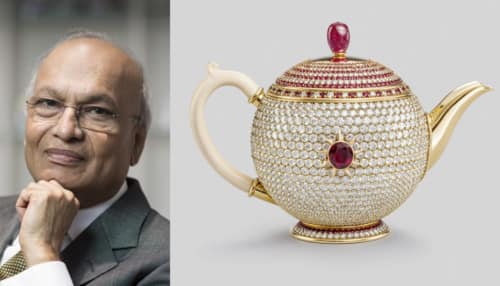- News>
- Viral
Who Is Nirmal Sethia? The Indian-Origin Businessman Who Designed The World`s Most Expensive Teapot Worth Rs 25 Crore

Covered in diamonds and ruby-studded, the valuable teapot reportedly also includes ivory details. The controversial name `The Egoist` was given to the award-winning teapot because it can only hold one cup of tea.
In 2016, Guinness World Records categorised a diamond and ruby-studded teapot as the most expensive teapot ever made. This gleaming dish, known as "The Egoist," was commissioned by the N Sethia Foundation, a UK charity established by British-Indian entrepreneur Nirmal Sethia.
The first teapots were created in China, and they quickly spread around the world as a necessary piece of tableware. A successful businessman of Indian descent named Nirmal Sethia made history in 2016 when he built the $3 million (about Rs. 25 crore) world's most expensive teapot.
The teapot known as "The Egoist" was ordered by the N Sethia Foundation, a charitable foundation founded in the UK by wealthy businessman Nirmal Sethia. The teapot was made by Italian goldsmith Fulvio Scavia, and Sethia's business, Newby Teas, financed the project.
What is The World Most Expensive Teapot Made Up of?
The teapot is made of 18-carat yellow gold and covered in 1,658 real diamonds and 386 real Thai and Burmese rubies. It also features a huge 6.67-carat ruby as the focal point. The handle of the teapot is made of mammoth ivory that is extinct.
It took about 1730 hours to make this masterpiece, according to the Guinness website, and working with Ice Age materials demands far more care and delicacy than working with ivory, which is already a challenging material.
Who is Nirmal Sethia?
Nirmal Sethia, was born in Kolkata in 1941, has spent more than 50 years residing in London. Early on, he had a keen interest in various tea varieties, and at the age of 16, he founded Sethia Tea Estates, his own business. Later, he bought a plantation for Assam tea.
But in 1965, he launched a new company by starting a company that dealt in jute, as noted by the BBC. With time, the business expanded to incorporate more endeavours like banking and real estate. But his steadfast passion for tea persisted.
In a GQ article, it is stated that he has a huge collection of more than 2,000 items. This collection contains tea-related objects from as far back as the 10th century BC. The museum preserves artefacts from several dynasties, including the Russian Romanov and Chinese Ming dynasties. The N Sethia Foundation is in charge of looking after this rare collection.
